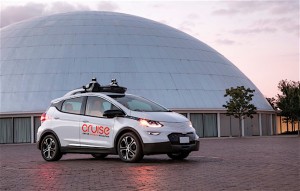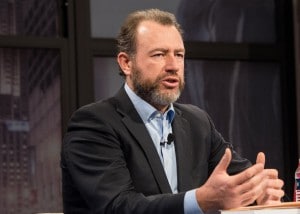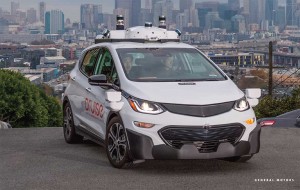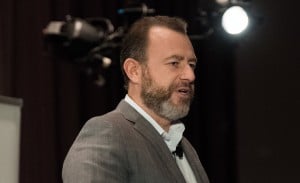Only a few hours after General Motors Co. unveiled its next big thing, the 2021 Chevrolet Suburban and Chevrolet Tahoe, the executive responsible for one of GM’s most important subsidiaries, Cruise Automation, said in new uncertain terms old fashioned motoring is now obsolete.
Dan Ammann, the former GM president, who has moved on to run Cruise, GM’s San Francisco-based automated-vehicle unit, said in a blog post this week that cars may have outlived the usefulness.
Imagine if someone invented a new transportation system and said, “I’ve designed a new way of getting around: It’s powered by fossil fuels that will pollute our air. It will congest our cities to the point of inciting rage in its users. Its human operators will be fallible, killing 40,000 Americans – and more than a million people around the world – every year.
(GM, Cruise put San Fran robo-taxi trial on hold)
“Most of the time, the equipment will sit unused, occupying prime real estate and driving up housing costs. If you’re young, old, or living with a disability, then you can’t use it. And for those who can, the privilege will cost $9,000 a year and suck up two years of your life,” Ammann wrote in a critique that lines up criticism of the automobile from hard-bitten critics of motor vehicle.

GM’s Cruise self-driving car unit received a new round of funding: $1.15 billion led by T. Rowe Price.
“You’d say, ‘You’re crazy.’ And yet, here we are, living in a state of cognitive dissonance with exactly this – the human-driven, gasoline-powered, single-occupant car – as our primary mode of transportation.”
Ammann said as Cruise works to earn trust in communities ahead of the launch of its self-driving service, he’s been spending time with city leaders and what he heard validated “my belief that the status quo of transportation is broken and that our need to find better solutions grows more urgent every day.”
Despite the best efforts of government, regulators and industry, very little has fundamentally changed in recent decades in terms of how we get around in the past two decades, Ammann added.
“More than three in four of us still drive to work in single-occupant vehicles, which is basically unchanged over the past 20 years. Electric vehicle adoption remains stubbornly stuck at under 1%. And, most importantly, traffic accidents are still the leading cause of death for 5- to 29-year olds, globally.
To be sure, public transit can and must help address some of these issues. But public transit often requires massive investment that many cities simply cannot afford. Even then, it only reaches a fraction of the population.
(GM’s Cruise Unit Gets Additional $1.15B in New Funding)
And while micro-mobility may offer some creative solutions, it only solves first/last mile problems for a small segment of the population, and only in certain communities.
Ammann said the rise of ride-sharing hasn’t solved the problem. In fact, what was intended to upend has only served to further entrench the status quo.
“Despite making up less than 1% of all vehicle miles traveled, ride-sharing has added further congestion, more emissions, and potentially even decreased safety in our cities from over-tired and overworked drivers. That’s because this ‘disruption’ is mostly built out of what’s causing the fundamental problem – the human-driven, gasoline-powered, single-passenger car.
“The result is that what we call ride-sharing isn’t really ride-sharing – it’s actually just ride-hailing. So while these apps have disrupted the taxi industry with subsidized rides at the push of a button, they haven’t fixed transportation,” Ammann added.
To make order-of-magnitude – rather than incremental – improvements in transportation, we need to build alternatives that are superior to the status quo in every way.
Ammann added Cruise, which has helped prop up the price of GM shares for months with its promise of high-tech AVs, believes it has a mission to improve safety by removing the human driver, to reduce emissions by being all-electric and to reduce congestion by making shared rides more compelling at a radically lower cost.
(SoftBank invests $2.25 billion in GM Cruise)
“Only then will we truly move beyond the car to the transportation system that we deserve – one that is safer, more affordable, and better for us, for our cities, and for our planet,” Ammann said.




What if I said “I’ve developed a method of getting around wherever and whenever you like without having to wait for someone to do it for you. You can travel alone or bring your family and friends with you. You can go places you’ve only read about. On your timetable.”?
I sell cars at Fikes Chevy (www.fikeschevy.com) and convincing Alabamans it’s better to lease than buy is an uphill battle.
Please sign my petition for Michigan’s Governor to be a mass transit leader in exchange for all communities in Wayne, Oakland and Macomb counties to opt into the SMART bus system. You only agree to improve mass transit if you sign. The Governor is the only person who can use CTF money to remove cars from roads, so if people see this they will want to ride buses more with 24/7 service and be willing to support the County Transit Authority in Southeast Michigan. The Petition is for all the World. http://savethefueltax.org